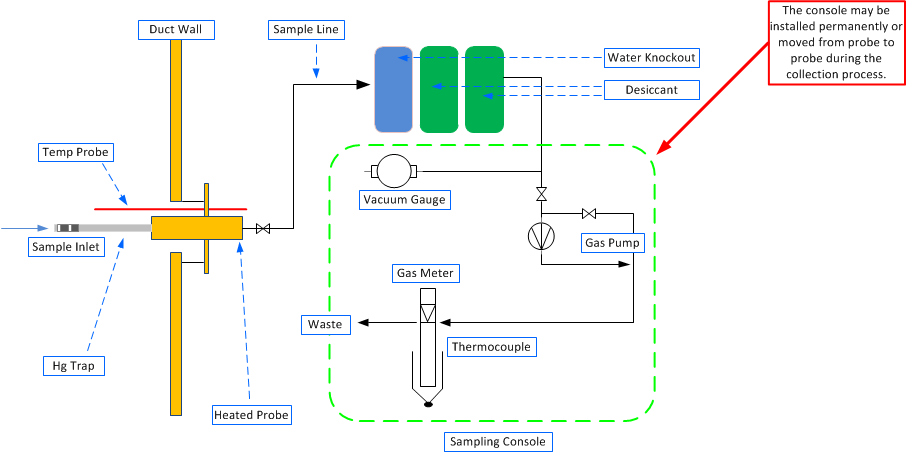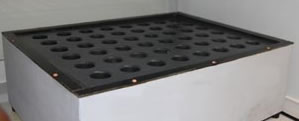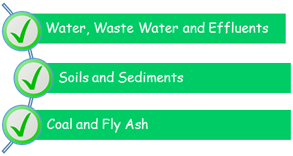US-EPA Method 30B
Determination of Total Vapor Phase Mercury Emissions from Coal-Fired Combustion Sources using Sorbent Traps
Method 30B is a procedure for measuring total vapour phase mercury (Hg) emissions from coal fired combustion sources using sorbent trap sampling and an extractive or thermal analytical technique. This method is only intended for use only under relatively low particulate conditions (e.g., sampling after all pollution control devices). The method was originally established to provide certainty and to measure relative accuracy of mercury continuous emission monitors.
The method is designed to measure the mass concentration of total vapour phase Hg in flue gas, including elemental Hg (Hg0) and oxidized forms of Hg (Hg+2), in micrograms per dry standard cubic meter (µg/m3).
Known volumes of flue gas are extracted from a stack or duct through paired, in-stack sorbent media traps at an appropriate flow rate. Collection of mercury on the sorbent media in the stack mitigates potential loss of mercury during transport through a probe/sample line. The sample traps are then analysed at a central location (either an in-house laboratory, or shipped to a contract facility).
The method allows for many sample points to be easily managed, simply and inexpensively. The method also offers some good benefits to the user especially in terms of ease of use and robustness.
Method Details
The overall method consists of three stages;
-
Sample collection
-
Sample preparation once collected (Acid Digestion)
-
Sample analysis
P S Analytical offer a total bundle for this method the so called PSA 30B Pack that contains all the equipment required to carry out this 3 step method.
There are slight variations in configuration depending on the exact requirements and we urge you to discuss your requirements with the PS Analytical representatives.
Stage 1 Sample Collection
The Sample collection apparatus consists of...
-
Either automated or manual console (sampling control)
-
Gas conditioner
-
Heated Sample Probe (various)
-
Heated Transfer Line
-
Traps (spiked or un-spiked)
Figure 1. A typical collection system shown for trap 1 only

Figure 2. Sorbent Trap Selection *

*There are a few different choices here so please contact your P S Analytical representative.
Stage 2. Sample preparation once collected (Hot Acid Digestion)
Once the sample has been collected it is returned to the laboratory for analysis. Prior to analysis the sorbent material must undergo wet acid digestion or direct combustion.
Whilst the wet acid digestion takes longer than direct combustion it is often preferred. As this is a batch process the samples may all be digested simultaneously and then loaded to the auto sampler for final analysis. The resultant digest is stable and may be kept and rerun (for better replicates) or reanalysed in the event of a questionable result several weeks or months after collection. Thermal desorption provides on single measurement so no precision data is obtained.
In addition the acid digest offers a much cleaner sample matrix which is easily handled by the end step analyser.
Weighed sorbent material is placed in the digestion vessel, acid is added and the solution is heated in the Hot Block. The resultant digest can be made-up-to-mark (in vessel), filtered (in vessel) and presented to the analyser for Hg determinations.
Figure 3. Hot Block for Acid Digests

Options for a 12, 36 or 54 place hot blocks are available and use either glass of polypropylene digestion vessels.
Stage 3. Analysis by Cold Vapour Atomic Fluorescence Spectrometry (CV-AFS)
The Millennium Merlin analyser combines the advantages of vapour generation techniques which removes most chemical interferences with the sensitivity and selectivity of atomic fluorescence spectrometry which allows mercury analysis down to sub ppt detection limits with 107x linearity.
-
10.025 Millennium Merlin - Cold Vapour Atomic Fluorescence Spectrometer (CV-AFS)
Capability Statement
The combination of the collection, preparation and analysis equipment described above gives the user full 30B capability.
However, with this equipment described the user may analyse the sorbent trap for 30B but also; water, waste water and effluents, soils and sediments, coal and fly ash samples.
 |
 |
Mercury in Air
By swapping the 10.025 Millennium Merlin for the 10.035 Millennium Merlin 1631 and Scarifier accessory this combination allows the above capability AND the determination of Hg in Air also.
If you would like any further information, please contact your P S Analytical representative or alternatively, fill in our Information Request page.






